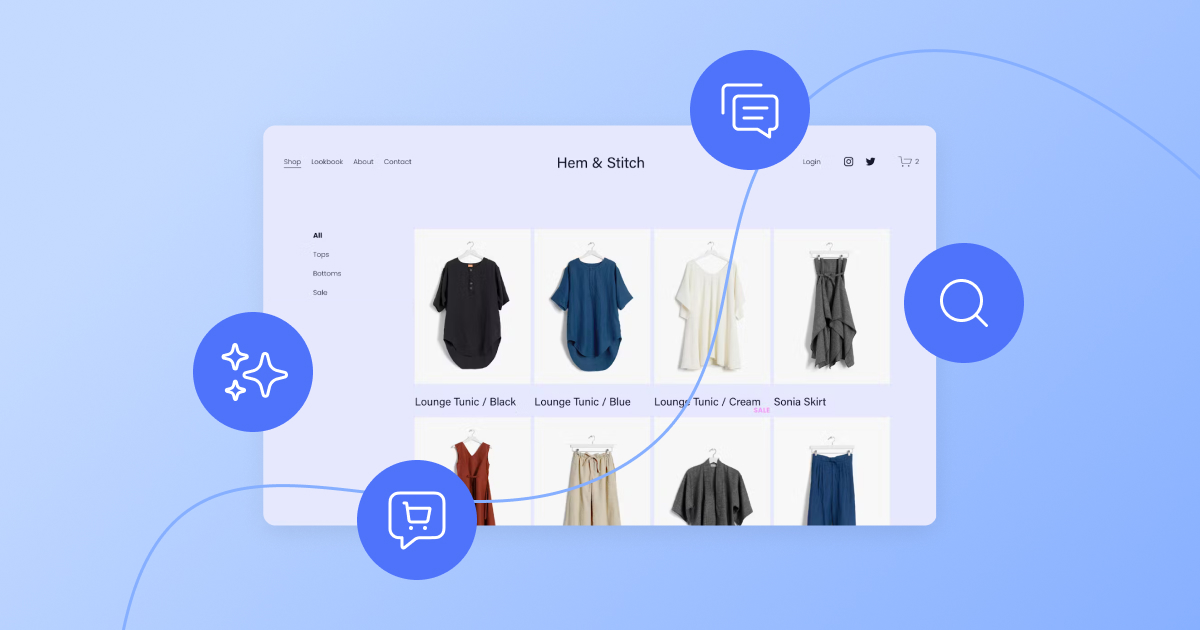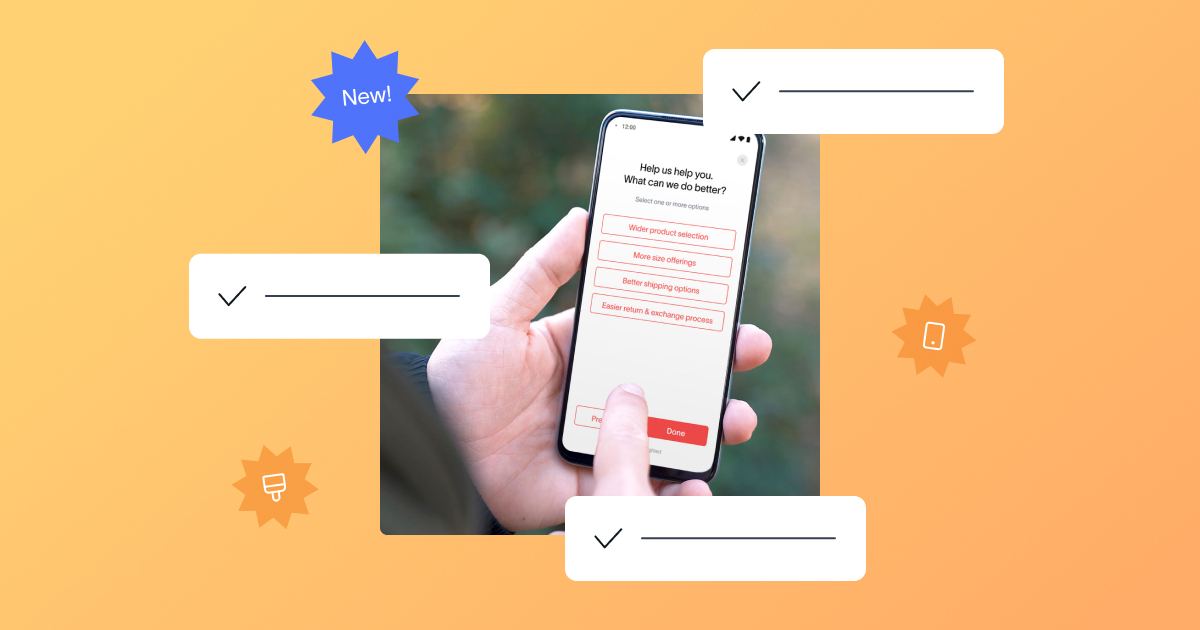What makes customers loyal to a brand? For over half of shoppers, it’s customer service. Even if you have the highest quality products or the most talented employees, whether or not customers choose you heavily depends on the service experience you provide. That’s why learning how to improve customer service is so important.
In this guide, we’ll look at additional data behind why improving customer service should always be a foundational business goal and provide tips on how to build an excellent customer service strategy.
The significance of great customer service
Brands across the globe are taking notice of how investing in great customer service can pay back dividends in the long run. Companies and researchers collect data year-over-year that supports the need for a dedicated customer service strategy:
- 96% of customers say superior customer service is important when choosing and being loyal to a brand.
- 94% of customers who consider their experience with a business as “very good” are likely to purchase that company’s additional products or services in the future.
- 78% of customers are likely to forgive a business for a mistake if they were provided exceptional customer service.
- 53% of support teams have seen an increase in customer support queries since COVID-19 hit.
But what happens when a business gets customer service wrong? Is the negative impact on a brand as drastic? The answer is a resounding yes.
With 52% of global consumers saying that most of their customer service interactions are fragmented, 70% of customers are claiming to leave a business after one poor customer service experience. That’s why customer service is an integral part of customer retention. Plus, good customer service is cost-effective since acquiring a new customer can cost 7x more than retaining an existing customer.
How to improve customer service: 3 key strategies
Enhancing your customer service is one of the most effective ways to build trust with customers while also creating lasting relationships with them. Next, we’ll cover how you can keep customers happy with the best strategies to improve customer service.
1. Measure and monitor customer service experience
Making unguided changes to your customer service strategy based on ‘feeling’ instead of measurement and benchmarking could end up hurting your support staff and the brand at large.
In fact, 77% of customers have a more favorable view of brands that ask for and accept customer feedback, making feedback collection and closing the loop on feedback paramount.
Actively collecting customer feedback to see what’s working well and what needs improvement can provide clear direction for how you and your customer service teams can improve the customer experience over time.
Routinely collect customer feedback
Customer Satisfaction Score (CSAT) and Customer Effort Score (CES) are two well-researched ways to collect customer feedback and instantly discover sentiment trends.
CSAT and CES surveys are particularly useful because of their simplicity. After a customer service experience, a customer is asked one question:
- CSAT: “How satisfied were you with [service provided/resolution of your issue]?”
- CES: “How easy did we make it to do X?”
These unambiguous and to-the-point survey questions allow you to measure specific types of customer interactions and clearly see which areas:
- Need the most improvement
- Can be quickly addressed
- Are the most pressing
For more detailed information about a specific customer service area, consider sending surveys to smaller, more targeted groups of customers. Some sample survey segments can include:
- Long-time customers
- Just made a 2nd purchase
- Recently wrote you a review
Or, dive deeper into how customers feel after a customer service interaction with Additional Questions. These open-ended follow-up questions extract qualitative feedback that can inform your customer service improvement strategies. You can ask questions like:
- AQ: Based on your experience today, would you return to [this service/store]?
- AQ: Is there anything that the customer service rep could have done to have made your experience better?
- AQ: Did you find the Help Center documentation useful in resolving your issue?
Monitor and respond to customers on social media and review sites
Your company’s reputation on social media can be both incredibly beneficial and painfully detrimental. Although complicated to dissect, the below stats highlight why attention to social media is worth the effort:
- 57% of consumers expect brands to respond on social media within a 12-hour window.
- The number of consumers who preferred messaging customer service on social media jumped 110% from 2020 to 2021.
- 29% of internet users use social media to discover/research/buy something.
- 30% of internet users are here to share their opinions (often about businesses).
Social media is a megaphone for your customers to share positive feedback about your brand, refer your product or service to others, and create organic brand awareness.
Unfortunately, that same megaphone can also be used to publicly express some incredibly sensitive grievances about your company or your customer service team.
While tracking everything mentioned on social media and responding to users is outside the scope of traditional customer service, being attentive to what your customers are saying can help you stay ahead of potential issues and prevent customer churn.
TIP: Connecting Twitter or other social accounts to team communication apps like Slack can keep the customer service teams aware of comments made on social media in real time for prompt response and issue resolution.
The same idea applies to review sites. 45% of people say they’re swayed to visit businesses that respond well to negative reviews on sites such as Yelp, Google My Business (GMB), or WebRetailer. Not only will customers update or change their review once a problem is solved, but responding to reviewers shows a strong value in customer service to potential customers.
2. Boost customer satisfaction with a self-service experience
Prioritizing customer care doesn’t always mean increasing the number of support call centers. Overwhelmingly, customers today want to be able to help themselves online.
A Zendesk survey found that 75% of customers think that self-service is the most convenient way to get help. From how-to videos to actionable blog posts, making information accessible and easy to find will yield an overall better customer experience.
Delighted uses this customer self-service model in the Customer Concierge’s Help Center. The resource hub includes detailed articles and step-by-step guides to support self-service throughout every aspect of the Delighted survey experience.
When customers can help themselves, they generally feel more content and confident with your brand.
3. Tune in to your customer service team
While putting customer satisfaction at the forefront of your brand is essential for business success, it’s still your employees who can make the greatest company impact. Time invested in measuring team satisfaction and employee training reduces employee and customer turnover.
Gather customer service team feedback
Open forum team meetings and calls for input from employees can be used to gather details, but they aren’t effective ways to get your finger on the pulse of your customer service department.
Similar to customer and NPS surveys, Employee Net Promoter Score (eNPS) surveys help you understand employee satisfaction.
Low customer support eNPS scores are a leading indicator that the support they are providing is not optimal and that they are potentially disengaged from your company’s messaging efforts.
Multiple studies attribute employee satisfaction to customer satisfaction. When companies prioritize employee experience management as well as the happiness of their support teams, customers are attended to with more care.
Improve customer service skills with active listening and empathy
According to the Harvard Business Review, the average listener can only recall about 25% of what someone has said. Active listening isn’t something that everyone does intuitively, but is crucial for customer service team members to master.
Most customers dislike having to repeat themselves to clarify something that they’ve overstated and active listening can play well in situations where customers may be trying to explain complicated scenarios.
Practice makes perfect. As either a formal or casual exercise for 10-15 mins a week, practice the art of active listening. In pairs, each team member should take turns talking about a specific topic for 1-2 minutes. Without distractions, the other person will reflect back on what the first person communicated and include empathetic language to show they understand. Then switch.
68% of customers expect the companies they interact with to exhibit empathy and exercises in active listening can help foster empathetic communication naturally in customer conversations.
Learn more about active customer listening here.
Maintain good customer service with expanded knowledge
Put tools into your customer service team’s hands to enhance their understanding of not only what they do but also what other departments do. A customer service agent may need to be an expert in cross-department knowledge and should have access to up-to-date training materials for their reference.
- Sandboxes: These are internal sections of your website where an employee can create a mock order, walk through a process, start a chat, and see things from the customer’s point of view.
- Cross-departmental meet and greets: Invite peers from other departments to a meeting to answer questions, show a presentation, and help your agents better understand what they do.
- Review existing resources regularly: Do they need to be updated? Are they accurate? A customer service team is only as good as the accuracy of the knowledge you put at their fingertips.
Of the many ways to improve customer service, collecting feedback gives you a high-level view of what’s working well and what needs to be improved in your customer service strategy. Start sending customer service surveys in minutes by signing up for free today.







